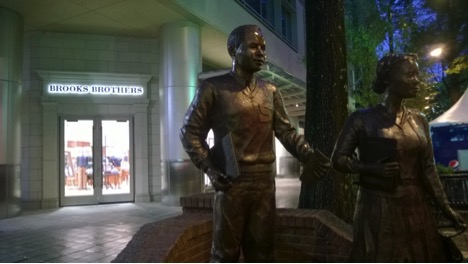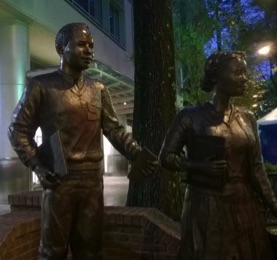by Melissa Summer Wells, Julia López-Robertson, and Gina Crosby-Quinatoa, University of South Carolina
Will the words end, I ask
whenever I remember to.
Nope, my sister says, all of five years old now,
and promising me/infinity. (p. 62-63)
Our next stop on our tour of young protagonists searching for their places in the world brings us to Jacqueline Woodson, protagonist — and author of Brown Girl Dreaming. Woodson is noted for ability to give voice to perspectives often passed over in children’s literature — of a slave girl sold away from her family who finds her voice in quilts in Show Way, of a Black girl who confronts segregation by sitting on the fence separating her from their white neighbors in The Other Side — with relevance, truth, and utmost beauty. Her newest book, Brown Girl Dreaming, invites readers into her childhood, one not without its own struggles to locate her own identity.
Through a series of free verse poems, Woodson expresses her childhood journey of self-discovery. Amidst the Civil Rights movement in the 1960s, she struggled to “find” herself between her two homes: Greenville, South Carolina, and Brooklyn, New York. Woodson’s mother grew up in Nicholtown, an area in Greenville where mostly Black families lived, and still do. Woodson struggled to make sense of the arbitrary rules imposed upon her brown skin: not to sit in the front of the bus, not to say ain’t because her mother wanted her children to speak the “right” way, not to wear an Afro, to be served last in stores, and to be followed in shops to make sure she didn’t steal anything. She also witnessed her family advocating for change in Greenville by joining the sit-ins at Woolworth’s and planning and participating in marches. Through these poems, Woodson shares her experiences of the Civil Rights movement with candor, humanism, and beauty that is largely absent in most accounts of this historical event directed toward younger readers.
Furthermore, Woodson shares stories about herself that may resonate with young readers who do not frequently see themselves in literature. Her childhood shared between Greenville and Brooklyn made her acutely aware of not fitting in: her Southern dialect was ridiculed in New York, and her Northern-speed speech was scorned in South Carolina. She recounts memories growing up as a Jehovah’s Witness and her awareness of having different religious practices than her friends. In the poem “The Promise Land” (p. 300-301), Woodson recalls when her Uncle Robert became a Muslim and invited her to participate in some of his new religious practices. Even though telling stories came naturally, she sheds light on her struggles to read and write early in her school career, until one teacher recognized her skill as a writer. Just as she shares her own critical discovery in “Stevie and Me” — that if she hadn’t read Stevie, “I’d never have believed/that someone who looked like me/could be in the pages of the book/that someone who looked like me/had a story” — we think Brown Girl Dreaming will foster that same connection with countless readers looking for literature that mirrors their own experiences. Other children’s literature can add to extended conversations about the identity themes Woodson addresses, such as linguistic diversity (Don’t Say Ain’t, Irene Smalls; Pepita Talks Twice/Pepita Habla Dos Veces, Ofelia Dumas Lachtman), race (Skin Again, bell hooks; The Colors of Us, Karen Katz); and socioeconomic diversity (Friends from the Other Side/Amigos del otro lado, Gloria Anzaldua).
We enjoyed the opportunity to read her words and her world (Freire & Macedo, 1987), a South Carolina world with which we share a geographical connection. Woodson’s poems share a historical counternarrative to the shiny, innovative downtown that Greenville boasts today. Her vivid imagery of growing up in the Nicholtown community humanizes an area commonly labeled from a deficit perspective as a “bad side of town.” As she described the sit-ins in downtown Greenville, we couldn’t help but imagine these brave ghosts of a pre-civil rights past — a past quietly overlooked by casual passersby in the current bustle of Greenville’s recently revitalized downtown — and wonder which of the re-branded, re-designed historic downtown buildings may have housed these sit-ins. As it turns out, the blur of downtown construction that met Melissa in her freshman year of college in the Greenville area was the demolition of the exact Woolworth’s that Woodson references in this book. The new bronze statue that she remembered appearing on the corner of Washington and Main Streets honored the legacy of Sterling High School — the first all-black public high school in Greenville County where Woodson’s mother was a student — that burned down in 1967 because of the students’ participation in the civil rights movement. That statue, however, doesn’t continue the story as Woodson does: “After the fire the students weren’t allowed to go to/the all-white high school./Instead they had to crowd in/beside their younger sisters and brothers/at the lower school” (p. 111). While cities will always be growing and changing, it is important to recognize the past and how it continues to shape the future—how the world we read and write informs the words we read and write.
Woodson recognizes the power embedded in words that so many readers seek: “Will the words end, I ask/whenever I remember to./Nope, my sister says, all of five years old now,/and promising me/infinity” (p. 62-63). Despite her childhood struggles to discover her own identity, words were — and always will be — her promise of infinity, a promise she passes on to her own readers.
 Statue in downtown Greenville, SC, honoring the Sterling High students who participated in the sit-ins at Woolworth’s, originally at this location. The Woolworth’s building was recently demolished and a large high-rise, including this Brooks Brothers store, stands in its place.
Statue in downtown Greenville, SC, honoring the Sterling High students who participated in the sit-ins at Woolworth’s, originally at this location. The Woolworth’s building was recently demolished and a large high-rise, including this Brooks Brothers store, stands in its place.
Photo Credit: Melissa Summer Wells
Freire, P., & Macedo, D. (1987). Literacy: Reading the word and the world. Westport, CT: Bergin & Garvey.
Woodson, J. (2001). The Other Side. New York, NY: G.P. Putnam’s Sons Books for Young Readers.
Woodson, J. (2005). Show Way. New York, NY: G.P. Putnam’s Sons Books for Young Readers.
Woodson, J. (2014). Brown Girl Dreaming. New York, NY: Nancy Paulsen Books.
Journey through Worlds of Words during our open reading hours: Monday-Friday, 9 a.m. to 5 p.m. and Saturday, 9 a.m. to 1 p.m. To view our complete offerings of WOW Currents, please visit archival stream.
- Themes: Gina Crosby-Quinatoa, Julia López-Robertson, Melissa Summer Wells
- Descriptors: Books & Resources, WOW Currents

